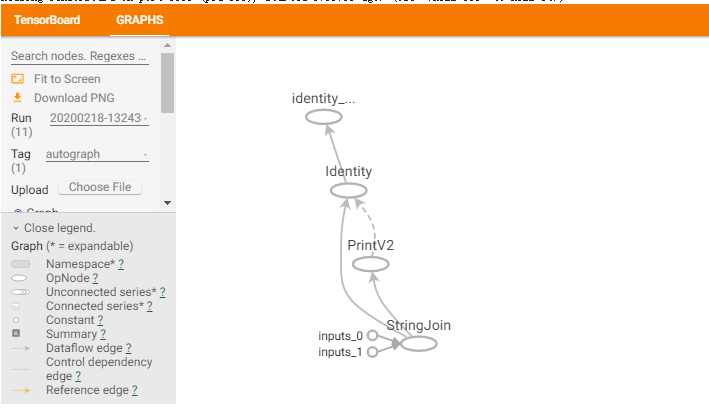有三种计算图的构建方式:静态计算图,动态计算图,以及Autograph.
在TensorFlow1.0时代,采用的是静态计算图,需要先使用TensorFlow的各种算子创建计算图,然后再开启一个会话Session,显式执行计算图。
而在TensorFlow2.0时代,采用的是动态计算图,即每使用一个算子后,该算子会被动态加入到隐含的默认计算图中立即执行得到结果,而无需开启Session。
使用动态计算图即Eager Excution的好处是方便调试程序,它会让TensorFlow代码的表现和Python原生代码的表现一样,写起来就像写numpy一样,各种日志打印,控制流全部都是可以使用的。
使用动态计算图的缺点是运行效率相对会低一些。因为使用动态图会有许多次Python进程和TensorFlow的C++进程之间的通信。而静态计算图构建完成之后几乎全部在TensorFlow内核上使用C++代码执行,效率更高。此外静态图会对计算步骤进行一定的优化,剪去和结果无关的计算步骤。
如果需要在TensorFlow2.0中使用静态图,可以使用@tf.function装饰器将普通Python函数转换成对应的TensorFlow计算图构建代码。运行该函数就相当于在TensorFlow1.0中用Session执行代码。使用tf.function构建静态图的方式叫做 Autograph.
一,计算图简介
计算图由节点(nodes)和线(edges)组成。
节点表示操作符Operator,或者称之为算子,线表示计算间的依赖。
实线表示有数据传递依赖,传递的数据即张量。
虚线通常可以表示控制依赖,即执行先后顺序。
二,静态计算图
在TensorFlow1.0中,使用静态计算图分两步,第一步定义计算图,第二步在会话中执行计算图。
TensorFlow 1.0静态计算图范例
import tensorflow as tf # 定义计算图 g = tf.Graph() with g.as_default(): #placeholder为占位符,执行会话时候指定填充对象 x = tf.placeholder(name='x', shape=[], dtype=tf.string) y = tf.placeholder(name='y', shape=[], dtype=tf.string) z = tf.string_join([x,y],name = 'join',separator=' ') # 执行计算图 with tf.Session(graph = g) as sess: print(sess.run(fetches = z,feed_dict = {x:"hello",y:"world"}))
TensorFlow2.0 怀旧版静态计算图
TensorFlow2.0为了确保对老版本tensorflow项目的兼容性,在tf.compat.v1子模块中保留了对TensorFlow1.0那种静态计算图构建风格的支持。
可称之为怀旧版静态计算图,已经不推荐使用了
import tensorflow as tf g = tf.compat.v1.Graph() with g.as_default(): x = tf.compat.v1.placeholder(name='x', shape=[], dtype=tf.string) y = tf.compat.v1.placeholder(name='y', shape=[], dtype=tf.string) z = tf.strings.join([x,y],name = "join",separator = " ") with tf.compat.v1.Session(graph = g) as sess: # fetches的结果非常像一个函数的返回值,而feed_dict中的占位符相当于函数的参数序列。 result = sess.run(fetches = z,feed_dict = {x:"hello",y:"world"}) print(result)
b'hello world'
三,动态计算图
在TensorFlow2.0中,使用的是动态计算图和Autograph.
在TensorFlow1.0中,使用静态计算图分两步,第一步定义计算图,第二步在会话中执行计算图。
动态计算图已经不区分计算图的定义和执行了,而是定义后立即执行。因此称之为 Eager Excution.
Eager这个英文单词的原意是"迫不及待的",也就是立即执行的意思。
# 动态计算图在每个算子处都进行构建,构建后立即执行 x = tf.constant("hello") y = tf.constant("world") z = tf.strings.join([x,y],separator=" ") tf.print(z)
hello world
# 可以将动态计算图代码的输入和输出关系封装成函数 def strjoin(x,y): z = tf.strings.join([x,y],separator = " ") tf.print(z) return z result = strjoin(tf.constant("hello"),tf.constant("world")) print(result)
hello world
tf.Tensor(b'hello world', shape=(), dtype=string)
四,TensorFlow2.0的Autograph
动态计算图运行效率相对较低。
可以用@tf.function装饰器将普通Python函数转换成和TensorFlow1.0对应的静态计算图构建代码。
在TensorFlow1.0中,使用计算图分两步,第一步定义计算图,第二步在会话中执行计算图。
在TensorFlow2.0中,如果采用Autograph的方式使用计算图,第一步定义计算图变成了定义函数,第二步执行计算图变成了调用函数。
不需要使用会话了,一些都像原始的Python语法一样自然。
实践中,我们一般会先用动态计算图调试代码,然后在需要提高性能的的地方利用@tf.function切换成Autograph获得更高的效率。
当然,@tf.function的使用需要遵循一定的规范,我们后面章节将重点介绍。
import tensorflow as tf # 使用autograph构建静态图 @tf.function def strjoin(x,y): z = tf.strings.join([x,y],separator = " ") tf.print(z) return z result = strjoin(tf.constant("hello"),tf.constant("world")) print(result)
hello world
tf.Tensor(b'hello world', shape=(), dtype=string)
import datetime # 创建日志 stamp = datetime.datetime.now().strftime("%Y%m%d-%H%M%S") logdir = './data/autograph/%s' % stamp writer = tf.summary.create_file_writer(logdir) # 开启autograph跟踪 tf.summary.trace_on(graph=True, profiler=True) # 执行autograph result = strjoin("hello","world") # 将计算图信息写入日志 with writer.as_default(): tf.summary.trace_export( name="autograph", step=0, profiler_outdir=logdir) # 启动 tensorboard在jupyter中的魔法命令 %load_ext tensorboard # 启动tensorboard %tensorboard --logdir ./data/autograph/

参考:
开源电子书地址:https://lyhue1991.github.io/eat_tensorflow2_in_30_days/
GitHub 项目地址:https://github.com/lyhue1991/eat_tensorflow2_in_30_days